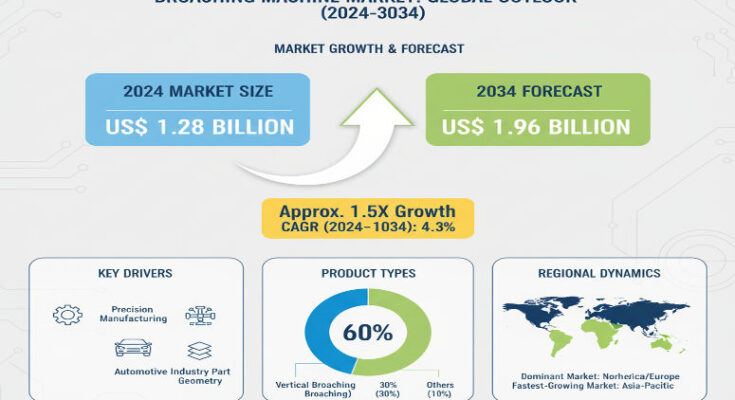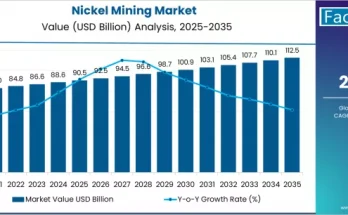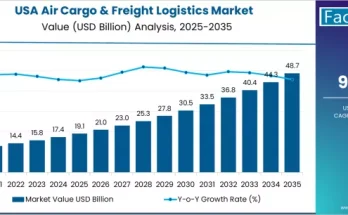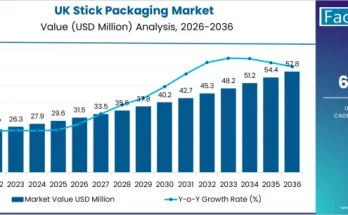In 2024, the global broaching machine market is estimated at approximately US$ 1.28 billion. Over the period from 2024 to 2034, the market is forecast to grow at a compound annual growth rate (CAGR) of around 4.3%, reaching about US$ 1.96 billion by end-2034. Alternative projections suggest similar growth paths, with some reports estimating the 2025 base around US$ 1.59–1.70 billion and expecting values near US$ 2.45–2.50 billion by 2034 or 2035, depending on geography and segment performance.
Key Market Drivers & Trends
Broaching machines are benefitting from several intersecting trends. First, the rise of electric and hybrid vehicles is pushing manufacturers to produce high-precision gears, splines, transmission parts, and internal profiles — areas where broaching machines excel. Second, there is increasing pressure to reduce cycle time and improve efficiency, pushing innovations in automation, tooling, and machine design. Third, demand for surface finish and dimensional accuracy in aerospace, defense, and precision machinery is strong. Finally, flexible manufacturing has become more desirable; manufacturers want broaching machines that offer modularity, faster setup, and compatibility with smart manufacturing or Industry 4.0 concepts.
There is also growing interest in integrating digital features: condition monitoring, predictive maintenance, robotics for loading/unloading, and faster changeovers.
Segment Insights: Types & Industries
Among broaching machine types, vertical broaching machines are expected to capture a substantial share by 2034, reflecting their suitability for applications where precision and rigidity matter. Horizontal and surface broaching machines also remain important, especially in heavy machinery, large parts, and for certain external broaching tasks.
In terms of end-use industries, the automotive sector is the largest contributor, using broaching machines for transmission components, steering systems, and drivetrain parts. The aerospace & defense industries are also key markets, driven by high quality, high tolerance demands. Additional applications include general industrial machinery, metal fabrication, and precision engineering.
Regional Insights: North America, Asia-Pacific & Key Markets
North America is expected to hold a large share of revenue toward 2034. The U.S. market alone is significant, benefiting from strong demand in automotive, aerospace, defense, and infrastructure. Manufacturers are investing in automation and precision tooling to stay competitive.
Asia-Pacific shows particularly strong growth potential. Countries such as Japan, China, India, South Korea are investing in manufacturing capacity and modernization. Growth rates in this region tend to outpace global averages, driven by increasing industrialization, infrastructure development, and adoption of advanced manufacturing tools.
Other regions such as Europe maintain strong positions especially in high-precision industries and where regulatory/quality standards are stringent. Emerging markets, though starting from smaller bases, are also contributing incremental demand.
Recent Developments & Innovations
Recent years have seen several notable innovations in the broaching machine market. Tool manufacturers are introducing hybrid broach machines, combining hydraulic and electro-hydraulic drive systems to improve energy efficiency and precision. There is progress in tooling materials (improved carbide inserts, coatings) that extend tool life and improve surface finish. Automation has become more common, including robotic loading/unloading, automatic broach tool changes, and integration with digital monitoring systems.
Another development is the shift toward supporting smaller batch sizes and higher mix manufacturing — driven by customization demands — which requires broaching systems that are more flexible, faster to set up, and less costly to change over.
Key Players & Competitive Landscape
Prominent companies in the broaching machine market include Mitsubishi Materials / Mitsubishi Heavy Industries, Nachi-Fujikoshi, The Ohio Broach & Machine Co., Pioneer Broach Company, General Broach Company, Arthur Klink GmbH, Forst Technologies GmbH & Co. KG, Broaching Machine Specialties, Accu-Cut Diamond Tool Co., Axisco Precision Machinery, Hoffmann Rumtechnik GmbH, and others.
These players compete based on precision, machine capacity, tooling innovation, customer service, automation features, and adaptability for different industries. Some are expanding into digital offerings, remote diagnostics, and aftermarket services.
Challenges & Barriers
Despite growth, the market faces several constraints. High capital cost of broaching machines and tooling is a major barrier for smaller manufacturers. Tool wear, setup time, and maintenance can reduce perceived economic appeal unless mitigated by efficient tooling, automation, or high utilization. Supply chain disruptions, especially for high-quality materials for broach tools, can affect production schedules. Also, skills shortages can hamper adoption of more complex, automated broaching systems.
Browse Full Report: https://www.factmr.com/report/broaching-machine-market
Outlook & Strategic Implications
Looking ahead, the broaching machine market is set for steady, mid-single digit growth. Opportunities lie with firms that can deliver value in precision and automation. Manufacturers who focus on reducing cycle time, improving tooling and maintenance, integrating smart controls and predictive diagnostics will capture premium share. Demand in EV component manufacturing, aerospace, and precision-machined parts will remain central. Asia-Pacific is likely to be a growth engine, while North America and Europe will continue to set quality and technology expectations.
For suppliers, strategic priorities include improving tooling materials, modular machine architecture, digital integration, and offering flexible ownership or service models. For end users, the premium will be on total cost of ownership, reliability, and precision rather than just upfront cost.



